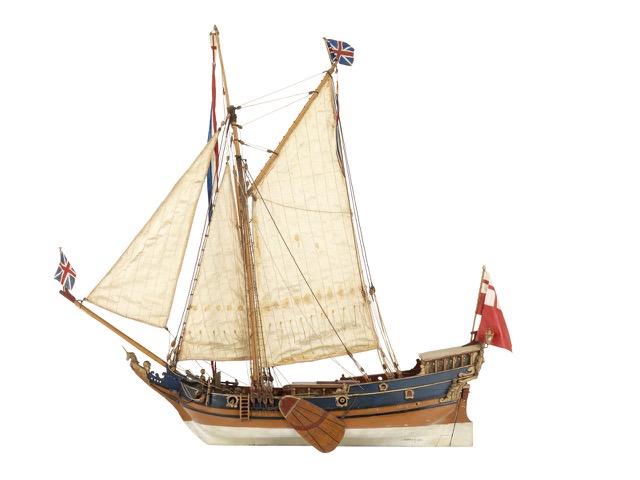
HMY Mary
Dutch built "Jacht" presented to Charles II in 1660
92 tons (bm); 67' x 18.5'; 8 3-pounder guns
Hit Skerries and sank on voyage Dublin to Chester 25 March 1675
Captain William Burstow, crew 27, passengers 46; survivors 39, lost 35
The Mary was built by the Dutch East India Company (VOC) in 1660 and purchased by the City of Amsterdam, embellished and given to Charles II when he was restored to the English throne. Descriptions of the Mary's construction, dimensions and equipment are contained within the archives in Amsterdam. The vessel's subsequent history is referred to in the contemporary diaries of Samuel Pepys and John Evelyn. The vessel was built for speed and had leeboards in order to combine a large sail area with a shallow draught. A long spar or spit supported the mainsail (e.g. gaff rigged). However, Charles II wanted a faster vessel improving on the design. The following year Phineas Pett built the KATHERINE for his use. The Mary was demoted to transporting officials between Dublin and Holyhead.
Model of Royal Yacht Mary:

On 25 March 1675, the Mary was on passage from Dublin to Chester
with a crew of 28, plus 3 noblemen and 43 other passengers. The
passengers included the Earl of Ardglass, and the Earl of Meath and his
son. The vessel encountered thick fog and struck a rock and was
subsequently wedged in a gully on the west of the Skerries. The tall
mast was touching the rocky outcrop and allowed 39 of the passengers and
crew to scramble ashore to the main part of the Skerries [which are
above water at all tidal states]. The captain bravely went back along
the mast to try and save the Earl of Meath, only to lose his own life in
the attempt. The survivors were able to make a fire with a cask of
gunpowder and wreck timbers to roast some mutton. A "runlet of
Usquebough" also washed ashore and the survivors were able to divide
this whisky amongst them to drink.
A Wicklow vessel
from Beaumaris went as near the isle [Skerries] as she durst and took in the 15
passengers and 24 seamen and landed them Sunday last [2 days later] at Beaumaris.
There are no historical records of any salvage attempts, possibly due to the exposed nature of the site. The wreck site was found on 11 July 1971 by the members of the Chorley and Merseyside branches of the British Sub Aqua Club, one of the Bronze cannons was landed on the same day. A joint expedition was agreed working with Liverpool University, but in the interim at least four guns were removed from the site which prompted a rapid rescue operation. These guns were subsequently recovered and placed into the care of the Receiver of Wrecks. The nine bronze guns, a large iron anchor, finds of both organic and inorganic materials, and concretions were taken to Liverpool City Museums Conservation Department. The Mary appears to have carried three sizes of ordnance; two Dutch, six English and one small degraded and unidentified gun of continental origin. All are muzzle loaders. The Dutch guns are four pounders and have the maker's mark "Gerald Koster 1660". The small gun may be from the wreck of another nearby 19th century vessel. Human remains were recovered in 1975 and were determined to be from two individuals.
Investigations of the site have continued, including a down stream search
which failed to find any other significant remains. The National Museums and
Galleries on Merseyside now have over 1500 objects from the shipwreck, and
have a model of the original vessel on display. In 2008, the Museum published
the excavation report and a listing of the artefacts recovered.
Back to top